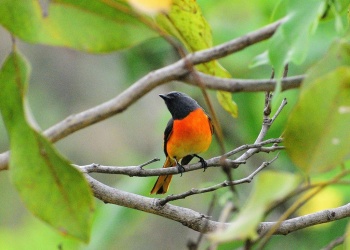- Pericrocotus cinnamomeus
Identification
16cm (6¼ in)
Male nominate
- Dark grey lores, face, ear-coverts, chin and lower throat
- Lighter grey forehead to back and scapulars
- Orange breast, fading to yellow on the belly
- Orange tail edges, rump and wing patches
- Dark beak
- Long wings
Female: grey upperparts, yellow underparts, tail edges, rump and wing patches.
Distribution
Southern Asia from the Indian subcontinent east to Indonesia.
Taxonomy

Male, Subspecies P. c. thai
Photo © by Oldnintheway
Queen Sirikit Park, Bangkok, Thailand, Feburary 2018
Photo © by Oldnintheway
Queen Sirikit Park, Bangkok, Thailand, Feburary 2018
Subspecies
There are 9 subspecies[1]:
- P. c. peregrinus: Himalayas and northern India
- P. c. pallidus: Pakistan (Indus River valley from Rann of Kutch to Punjab)
- P. c. malabaricus: West India (Western Ghats from Belgaum to Kerala)
- P. c. cinnamomeus: South peninsula India and Sri Lanka
- P. c. vividus: Andaman Islands
- P. c. thai: Myanmar to northern Thailand and Laos
- P. c. sacerdos: Cambodia and southern Vietnam
- P. c. separatus: South Myanmar (Mergui District) and southern peninsula Thailand
- P. c. saturatus: Java and Bali
.
Habitat
Forests including mangrove and thorn. Strand woodland and casuarinas
Behaviour
Breeding
They construct a cup shaped nest for their clutch of 2-4 spotted eggs. These are incubated by the female. They may be double-brooded in some areas.
Diet
Their diet consists of moths, caterpillars and other insects such as beetles and cicadas.
References
- Clements, J. F., T. S. Schulenberg, M. J. Iliff, D. Roberson, T. A. Fredericks, B. L. Sullivan, and C. L. Wood. 2017. The eBird/Clements checklist of birds of the world: v2017, with updates to August 2017. Downloaded from http://www.birds.cornell.edu/clementschecklist/download/
- Handbook of the Birds of the World Alive (retrieved Feb 2018)
- Wikipedia
Recommended Citation
- BirdForum Opus contributors. (2024) Small Minivet. In: BirdForum, the forum for wild birds and birding. Retrieved 23 April 2024 from https://www.birdforum.net/opus/Small_Minivet
External Links
GSearch checked for 2020 platform.







